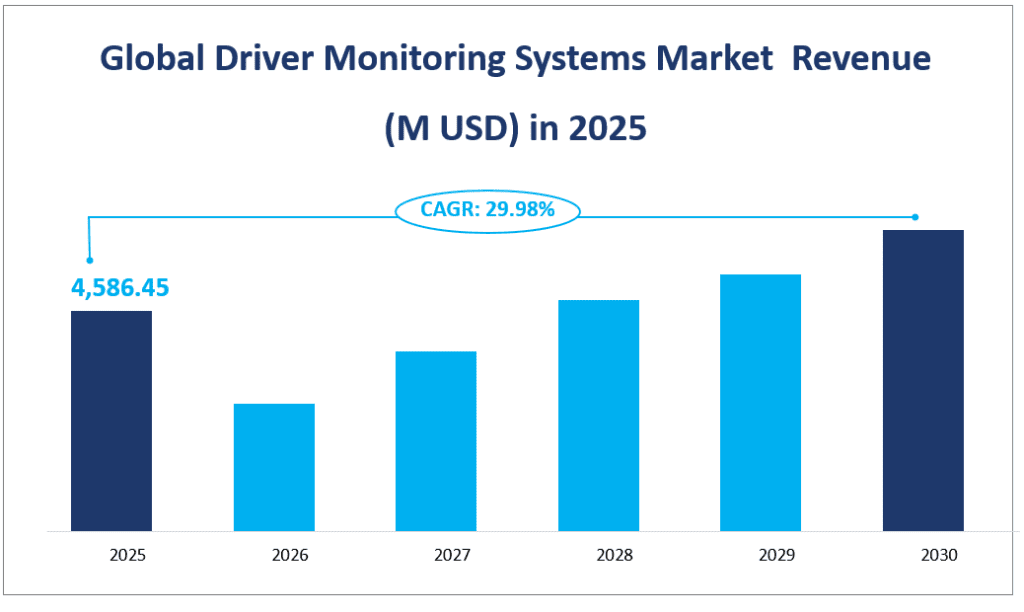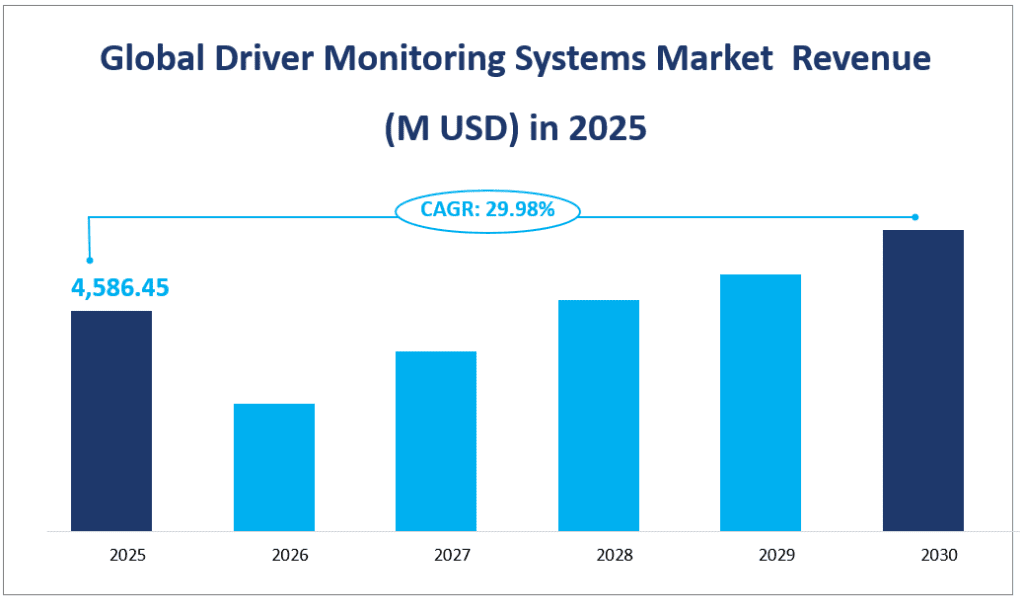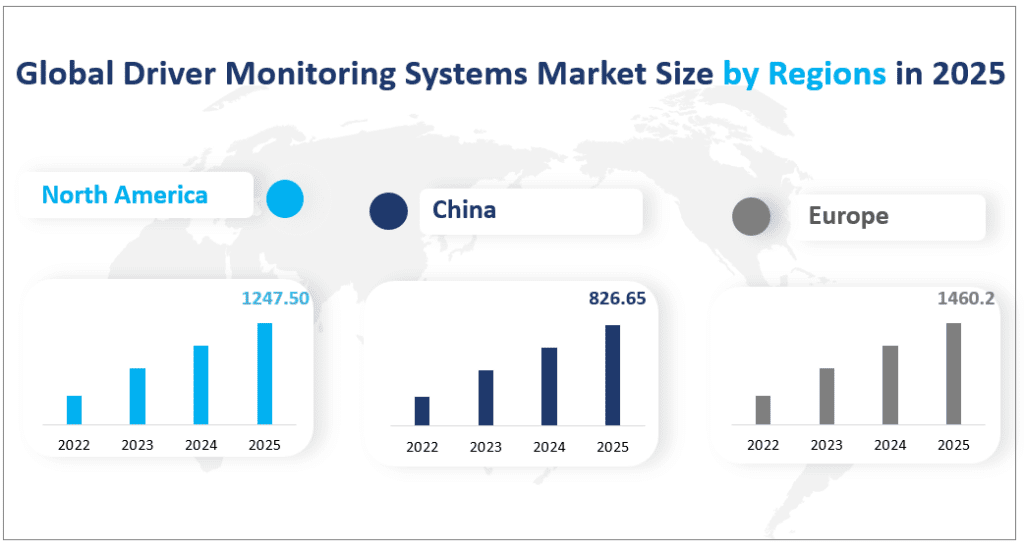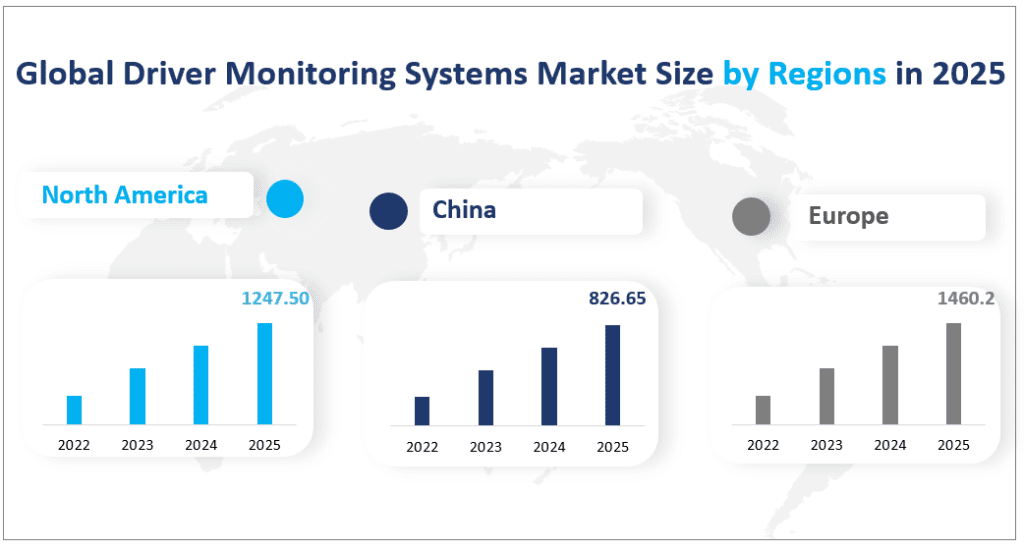1. Global Driver Monitoring Systems Market Projections
The global Driver Monitoring Systems market revenue is projected to reach an impressive $4,586.45 million with a CAGR of 29.98% from 2025 to 2030.
Driver Monitoring Systems are advanced technologies designed to enhance road safety by monitoring the driver’s alertness, attentiveness, and overall condition. These systems use a combination of cameras, sensors, and sophisticated algorithms to detect signs of fatigue, distraction, or drowsiness. The primary goal of DMS is to alert the driver when potential risks are identified, thereby preventing accidents and improving overall driving safety. Modern DMS solutions go beyond basic alert functions, offering personalized in-car experiences, health monitoring, and integration with other advanced driver assistance systems (ADAS).
Global Driver Monitoring Systems Market Revenue (M USD) in 2025


2. Driving Factors of Driver Monitoring Systems Market
Firstly, the increasing prevalence of advanced driver assistance systems (ADAS) in modern vehicles has created a demand for complementary technologies like DMS. As vehicles become more autonomous, ensuring that drivers remain alert and ready to take control when necessary is crucial. Regulatory requirements, such as those imposed by the European New Car Assessment Programme (Euro NCAP), are also driving the adoption of DMS.
Economic factors also play a significant role in the growth of the DMS market. The increasing middle-class population in regions like Asia-Pacific, particularly in countries like China and India, has led to higher demand for luxury vehicles equipped with advanced safety features. Additionally, the development of urban infrastructure and the rise in vehicle ownership have contributed to the need for safer driving solutions. Technological advancements in camera systems, infrared sensors, and artificial intelligence have made DMS more effective and affordable, further fueling market growth.
3. Limiting Factors of Driver Monitoring Systems Market
Despite the promising growth prospects, the DMS market faces several challenges. One of the primary concerns is the potential for privacy violations. The idea of a vehicle constantly monitoring the driver raises questions about data security and personal privacy. Ensuring that DMS technologies do not intrude on drivers’ privacy while still providing essential safety functions is a delicate balance that manufacturers must achieve.
Technical limitations also pose challenges. For example, the performance of vision-based DMS can be compromised by varying light conditions, leading to inaccurate readings. Additionally, defining and quantifying fatigue and drowsiness remains a complex task, as these states can manifest differently among individuals. The reliability of DMS algorithms and the speed of data processing are critical factors that need improvement to ensure accurate and timely alerts.
Furthermore, the market faces infrastructure and regulatory hurdles. The deployment of DMS on a large scale requires robust data management and cybersecurity frameworks to protect against potential threats. Uncertainties in data protection laws and varying regional regulations can complicate the implementation of DMS across different markets.
4. Diverse Applications of the Driver Monitoring Systems Market
The market share for DMS in commercial vehicles will be $48.12% in 2025, reflecting a robust expansion over the decade.
Commercial vehicles, which include trucks, buses, and other fleet vehicles, are critical for transportation and logistics industries. The integration of DMS in commercial vehicles is driven by the need to enhance road safety and reduce the risk of accidents caused by driver fatigue and distraction. Fleets often operate for extended periods, making driver alertness a paramount concern. DMS solutions in this segment not only monitor driver attentiveness but also provide data for fleet management, enabling
The market share for DMS in passenger vehicles has also seen substantial growth with 51.88% in 2025.
Passenger vehicles, including cars and SUVs, are increasingly adopting DMS to enhance safety and provide personalized driving experiences. Modern vehicles are equipped with advanced technologies, and DMS is becoming a standard feature in many new models. The growing demand for luxury vehicles and the increasing focus on safety and convenience are driving the adoption of DMS in this segment. Additionally, regulatory requirements and consumer awareness about safety features are contributing to the growth of DMS in passenger vehicles.
Market Revenue and Share by Segment
| Revenue (M USD) in 2025 | Market Share in 2025 | ||
| By Application | Commercial Vehicle | 2201.49 | 48.12% |
| Passenger Vehicle | 2339.08 | 51.88% |
5. Regional Driver Monitoring Systems Market Revenue by Major Regions in 2025
North America, comprising the United States, Canada, and Mexico, is a significant market for DMS. The region’s robust automotive industry, high consumer demand for advanced safety features, and stringent safety regulations drive the adoption of DMS. The United States, in particular, is a leader in technological advancements and consumer demand for luxury vehicles, contributing to the growth of DMS in the region. The market revenue for DMS in North America is expected to reach $1247.50 million by 2025, reflecting a substantial increase from previous years.
Europe is the largest regional market for DMS, accounting for over 31% of the global market share. The region’s strong automotive industry, advanced technological infrastructure, and regulatory mandates, such as those from Euro NCAP, have propelled the adoption of DMS. European countries, particularly Germany, the United Kingdom, and France, have a high demand for luxury vehicles equipped with advanced safety features. The market revenue for DMS in Europe is projected to reach $1460.2 million by 2025, driven by regulatory requirements and consumer preferences for safer vehicles.
China is one of the fastest-growing markets for DMS, driven by its rapidly developing automotive industry and increasing consumer demand for advanced safety features. The Chinese government’s focus on improving road safety and promoting the adoption of advanced technologies has contributed to the growth of DMS in the region. The market revenue for DMS in China is expected to reach $826.65 million by 2025, reflecting a significant increase from previous years. China’s large automotive market and growing middle-class population are key factors driving the adoption of DMS.
Europe holds the largest market share with 31.84%, making it the biggest regional market for DMS. The region’s strong automotive industry, advanced technological infrastructure, and regulatory mandates have propelled the adoption of DMS. European countries, particularly Germany, the United Kingdom, and France, have a high demand for luxury vehicles equipped with advanced safety features, contributing to the region’s dominant position.
China is one of the fastest-growing markets for DMS, driven by its rapidly developing automotive industry and increasing consumer demand for advanced safety features. The Chinese government’s focus on improving road safety and promoting the adoption of advanced technologies has contributed to the growth of DMS in the region.
Global Driver Monitoring Systems Market Size by Regions in 2025


6. Top 3 Companies in the Driver Monitoring Systems Market
Company Introduction and Business Overview:
Aisin Seiki, established in 1949, is a leading global automotive parts manufacturer based in Japan. The company is part of the Aisin Group, which comprises a vast collection of automotive companies. Aisin Seiki specializes in manufacturing motor vehicle parts such as transmissions, clutches, disc brakes, ABS, suspensions, oil pumps, power windows, and power door locks. The company has sales and production subsidiaries worldwide, making it a significant player in the automotive industry.
Products Offered:
Aisin Seiki offers a range of DMS solutions that focus on enhancing driver safety and comfort. Their DMS uses cameras and advanced algorithms to monitor driver alertness, detect signs of fatigue or distraction, and provide timely alerts. The company’s DMS solutions also include features for personalized in-car experiences, such as adjusting seat positions, mirror angles, and cabin temperatures based on driver preferences.
Company Introduction and Business Overview:
Seeing Machines, established in 2001, is an Australian company specializing in computer vision processing technologies. The company develops technologies that enable machines to see and track human faces and moving objects. Seeing Machines’ solutions are designed to improve road safety by monitoring driver alertness and detecting signs of fatigue or distraction.
Products Offered:
Seeing Machines’ DMS solutions use cameras and sophisticated algorithms to monitor driver attentiveness and provide real-time data to vehicle systems. Their DMS is critical for ensuring driver engagement and readiness to retake control in semi-autonomous and autonomous driving scenarios. The company’s solutions also include features for personalized driving experiences and health monitoring.
Company Introduction and Business Overview:
Faurecia, established in 1997, is a leading global automotive supplier based in France. The company operates 248 industrial sites and 37 R&D centers across 37 countries, employing over 100,000 people. Faurecia’s mission is to develop technologies for sustainable mobility and create personalized experiences for the cockpit of the future. The company’s focus on innovation and sustainability has made it a significant player in the automotive industry.
Products Offered:
Faurecia’s DMS solutions include vision-based systems that monitor driver alertness, detect signs of fatigue or distraction, and provide timely alerts. The company’s solutions also integrate with other advanced driver assistance systems (ADAS) to enhance overall vehicle safety. Faurecia’s DMS solutions offer personalized in-car experiences, such as adjusting seat positions, mirror angles, and cabin temperatures based on driver preferences.
Major Players
| Company Name | Business Distribution Region |
| Aisin Seiki | Worldwide |
| Seeing Machines | Worldwide |
| Faurecia | Worldwide |
| Eyesight | Mainly in Asia-Pacific |
| Adam | Mainly in Asia |
| Jabil Inc. | Worldwide |
| Edge3 | Mainly in US |
| Valeo SA | Worldwide |
| Bosch | Worldwide |
| Continental | Worldwide |
| Visteon Corporation | Worldwide |
| Veoneer (Autoliv) | Mainly in America, Europe, and APAC |
| NXP | Worldwide |
| Denso | Worldwide |
| Optalert | Mainly in North America, Europe |
| Jungo Connectivity (Pioneer) | Mainly in North America |
| Magna | Worldwide |
| PathPartner Technology Inc | Mainly in North America, Europe, Asia-Pacific |
| Harman | Worldwide |
| CardioID | Mainly in Europe |
| Affectiva | Mainly in North America |
1 Driver Monitoring Systems: Current Status
1.1 New functions of Driver Monitoring Systems
1.2 Driver Monitoring Systems Current Status & Applicable cars
1.2.1 Driver Monitoring Systems Current Status
1.2.2 Applicable Cars
1.3 Global Driver Monitoring Systems Value by Region (2015-2020)
1.3.1 Research Regions
1.3.2 Global Driver Monitoring Systems Value and Market Share by Region (2015-2020)
1.3.3 Global Driver Monitoring Systems Value and Gross Margin (2015-2020)
1.3.4 North America Driver Monitoring Systems Value and Gross Margin (2015-2020)
1.3.5 Europe Driver Monitoring Systems Value and Gross Margin (2015-2020)
1.3.6 China Driver Monitoring Systems Value and Gross Margin (2015-2020)
1.3.7 Japan Driver Monitoring Systems Value and Gross Margin (2015-2020)
1.3.8 Middle East and Africa Driver Monitoring Systems Value and Gross Margin (2015-2020)
1.3.9 India Driver Monitoring Systems Value and Gross Margin (2015-2020)
1.3.10 South America Driver Monitoring Systems Value and Gross Margin (2015-2020)
2 Next steps for Driver Monitoring Systems
2.1 Market opportunities of DMS
2.1.1 Market potential
2.1.2 Is the automotive industry facing a DMS boom?
2.1.3 Trend of Driver Monitoring Systems Industry
2.2 Market challenges of automotive DMS
2.2.1 Key concerns: What your car will know about you
2.2.2 Autonomous vehicles
2.3 Global Driver Monitoring Systems Value Forecast by Region (2020-2025)
2.3.1 North America Market Value Forecast (2020-2025)
2.3.2 Europe Market Value Forecast (2020-2025)
2.3.3 China Market Value Forecast (2020-2025)
2.3.4 Japan Market Value Forecast (2020-2025)
2.3.5 Middle East and Africa Market Value Forecast (2020-2025)
2.3.6 India Market Value Forecast (2020-2025)
2.3.7 South America Market Value Forecast (2020-2025)
2.3.8 Driver Monitoring Systems Market Forecast Under COVID-19
3 Driver Monitoring Systems: Definitions
3.1 Driver Monitoring System
3.2 Advanced Driver Monitoring System
3.3 Actuation techniques to alert the driver
4 Why Driver Monitoring Systems matter
5 Cars equipped with a Driver Monitoring System
5.1 Application of Driver Monitoring Systems
5.1.1 Commercial Vehicle Overview
5.1.2 Passenger Vehicle Overview
5.2 Global Driver Monitoring Systems Value and Market Share by Application (2015-2020)
5.3 Global Driver Monitoring Systems Value and Growth Rate by Application (2015-2020)
5.3.1 Global Driver Monitoring Systems Value and Growth Rate of Commercial Vehicle
5.3.2 Global Driver Monitoring Systems Value and Growth Rate of Passenger Vehicle
6 Driver Monitoring Systems in Autonomous Vehicles
6.1 Global Driver Monitoring Systems Market Size in Autonomous Vehicles (2015-2020)
6.1.1 Global Driver Monitoring Systems Revenue in Autonomous Vehicles (2015-2020)
6.2 Driver Monitoring Systems Market Size Forecast in Autonomous Vehicles (2020-2025)
6.2.1 Global Driver Monitoring Systems Revenue Forecast in Autonomous Vehicles (2020-2025)
7 Key OEMs Advancing Driver Monitoring Systems
8 Competitive Landscape
8.1 Competitive Profile
8.2 Aisin Seiki
8.2.1 Company Profiles
8.2.2 Driver Monitoring Systems Service Introduction
8.2.3 Aisin Seiki Revenue, Gross and Gross Margin (2015-2020)
8.3 Seeing Machines
8.3.1 Company Profiles
8.3.2 Driver Monitoring Systems Service Introduction
8.3.3 Seeing Machines Revenue, Gross and Gross Margin (2015-2020)
8.4 Faurecia
8.4.1 Company Profiles
8.4.2 Driver Monitoring Systems Service Introduction
8.4.3 Faurecia Revenue, Gross and Gross Margin (2015-2020)
8.5 Eyesight
8.5.1 Company Profiles
8.5.2 Driver Monitoring Systems Service Introduction
8.5.3 Eyesight Revenue, Gross and Gross Margin (2015-2020)
8.6 Adam
8.6.1 Company Profiles
8.6.2 Driver Monitoring Systems Service Introduction
8.6.3 Adam Revenue, Gross and Gross Margin (2015-2020)
8.7 Jabil Inc.
8.7.1 Company Profiles
8.7.2 Driver Monitoring Systems Service Introduction
8.7.3 Jabil Inc. Revenue, Gross and Gross Margin (2015-2020)
8.8 Edge3
8.8.1 Company Profiles
8.8.2 Driver Monitoring Systems Service Introduction
8.8.3 Edge3 Revenue, Gross and Gross Margin (2015-2020)
8.9 Valeo SA
8.9.1 Company Profiles
8.9.2 Driver Monitoring Systems Service Introduction
8.9.3 Valeo SA Revenue, Gross and Gross Margin (2015-2020)
8.10 Bosch
8.10.1 Company Profiles
8.10.2 Driver Monitoring Systems Service Introduction
8.10.3 Bosch Revenue, Gross and Gross Margin (2015-2020)
8.11 Continental
8.11.1 Company Profiles
8.11.2 Driver Monitoring Systems Service Introduction
8.11.3 Continental Revenue, Gross and Gross Margin (2015-2020)
8.12 Visteon Corporation
8.12.1 Company Profiles
8.12.2 Driver Monitoring Systems Service Introduction
8.12.3 Visteon Corporation Revenue, Gross and Gross Margin (2015-2020)
8.13 Veoneer (Autoliv)
8.13.1 Company Profiles
8.13.2 Driver Monitoring Systems Service Introduction
8.13.3 Veoneer (Autoliv) Revenue, Gross and Gross Margin (2015-2020)
8.14 NXP
8.14.1 Company Profiles
8.14.2 Driver Monitoring Systems Service Introduction
8.14.3 NXP Revenue, Gross and Gross Margin (2015-2020)
8.15 Denso
8.15.1 Company Profiles
8.15.2 Driver Monitoring Systems Service Introduction
8.15.3 Denso Revenue, Gross and Gross Margin (2015-2020)
8.16 Optalert
8.16.1 Company Profiles
8.16.2 Driver Monitoring Systems Service Introduction
8.16.3 Optalert Revenue, Gross and Gross Margin (2015-2020)
8.17 Jungo Connectivity (Pioneer)
8.17.1 Company Profiles
8.17.2 Driver Monitoring Systems Service Introduction
8.17.3 Jungo Connectivity (Pioneer) Revenue, Gross and Gross Margin (2015-2020)
8.18 Magna
8.18.1 Company Profiles
8.18.2 Driver Monitoring Systems Service Introduction
8.18.3 Magna Revenue, Gross and Gross Margin (2015-2020)
8.19 PathPartner Technology Inc
8.19.1 Company Profiles
8.19.2 Driver Monitoring Systems Service Introduction
8.19.3 PathPartner Technology Inc Revenue, Gross and Gross Margin (2015-2020)
8.20 Harman
8.20.1 Company Profiles
8.20.2 Driver Monitoring Systems Service Introduction
8.20.3 Harman Revenue, Gross and Gross Margin (2015-2020)
8.21 CardioID
8.21.1 Company Profiles
8.21.2 Driver Monitoring Systems Service Introduction
8.21.3 CardioID Revenue, Gross and Gross Margin (2015-2020)
8.22 Affectiva
8.18.1 Company Profiles
8.22.2 Driver Monitoring Systems Service Introduction
8.22.3 Affectiva Revenue, Gross and Gross Margin (2015-2020)
9 Appendix
9.1 Methodology
9.2 Research Data Source
